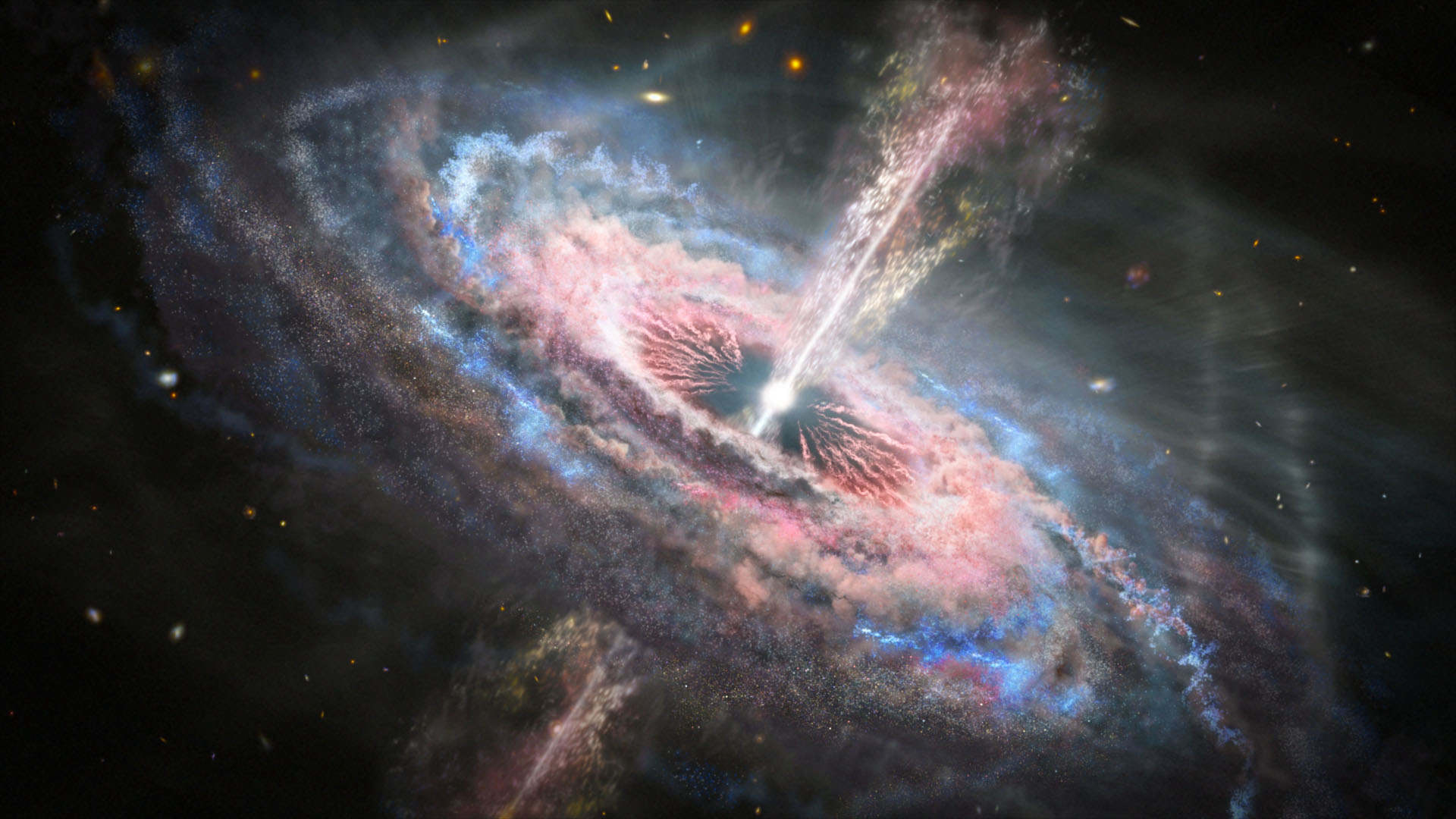2 merging supermassive black holes spotted at 'cosmic noon' in early universe
Supermassive black holes are lighting up the cores of two merging galaxies in the early universe.
Astronomers have spotted two quasars lighting up the mutual heart of colliding galaxies at a period in the universe's early history dubbed "cosmic noon."
The energetic quasars, or active galactic nuclei (AGNs), are powered by feeding supermassive black holes and are seen as they were just three billion years after the Big Bang, during a period of intense galactic growth and star formation, a new study reports.
Such a closely bound pair of energetic quasars are characteristic of merging galaxies, which go on to form massive elliptical galaxies. By investigating such events, astronomers can learn more about the evolution of galaxies and how the universe took the shape we see today.
"We don't see a lot of double quasars at this early time, and that's why this discovery is so exciting," study lead author Yu-Ching Chen, a graduate student at the University of Illinois, said in a statement. "Knowing about the progenitor population of black holes will eventually tell us about the emergence of supermassive black holes in the early universe, and how frequent those mergers could be."
Related: Black holes of the universe (images)
The galaxies that are seen in the contemporary universe close to our own Milky Way have grown and evolved through a steady process of continuous collisions and mergers. This has not only blended the stars of different galaxies together but has also triggered bouts of intense star formation.
The merger process supplies gas to galaxies' central supermassive black holes, which will also eventually merge and form even larger black holes. When these black holes feed on this material, they blast out massive amounts of radiation that can outshine all the stars in their home galaxy combined. This powers AGNs (of which quasars are a type) and links this phenomenon to galactic mergers.
Breaking space news, the latest updates on rocket launches, skywatching events and more!
While astronomers have had a lot of success in spotting galactic mergers with dual quasars in the local universe, more distant examples of such events that happened when the universe was much younger have been elusive.
That's what makes the new discovery so exciting, study team members said. They used a variety of ground and space-based telescopes to study a closely bound pair of actively feeding supermassive black holes at cosmic noon, about three billion years after the universe's birth.
The two quasars seen by the team are just 10,000 light-years apart, meaning that the merger between their host galaxies is well underway and they are close to becoming a single giant elliptical galaxy. This fact distinguishes the new discovery from similar observations, team members said, as other merging galaxies of the era have been seen in earlier stages of unification and can be clearly distinguished as separate entities.
Sighting and identifying such close black hole pairings in the early universe is incredibly difficult, because at such separations these cosmic titans are difficult to distinguish — unless each one is accreting material and shining as a quasar.
Just one in 100 supermassive black holes is actively swallowing material, however, so finding two together accreting matter at the same time is quite rare. This is despite the fact that astronomers think the early universe was packed with merging galaxies that possessed supermassive black hole pairings.
The first hints of the newfound system were discovered in data collected by the Hubble Space Telescope, appearing as no more than two closely aligned pinpricks of light. The study team investigated further by examining data collected by Europe's Gaia spacecraft, which revealed a "wobble" in the system that could be the result of the rate of material accreting to the black holes changing sporadically.
The Gemini Multi-Object Spectrograph and Gemini North Near-InfraRed instruments on the Gemini North telescope in Hawaii were then used to confirm that the two objects were indeed both quasars. This also provided an independent measurement of distance, which confirmed the astronomers were seeing these quasars as they were just three billion years after the Big Bang.
"The confirmation process wasn't easy, and we needed an array of telescopes covering the spectrum from X-rays to the radio to finally confirm that this system is indeed a pair of quasars, instead of, say, two images of a gravitationally lensed quasar," study co-author Yue Shen, an astronomer at the University of Illinois, said in the same statement.
The study was published online today (April 5) in the journal Nature.
Follow us on Twitter @Spacedotcom or on Facebook.

Robert Lea is a science journalist in the U.K. whose articles have been published in Physics World, New Scientist, Astronomy Magazine, All About Space, Newsweek and ZME Science. He also writes about science communication for Elsevier and the European Journal of Physics. Rob holds a bachelor of science degree in physics and astronomy from the U.K.’s Open University. Follow him on Twitter @sciencef1rst.


